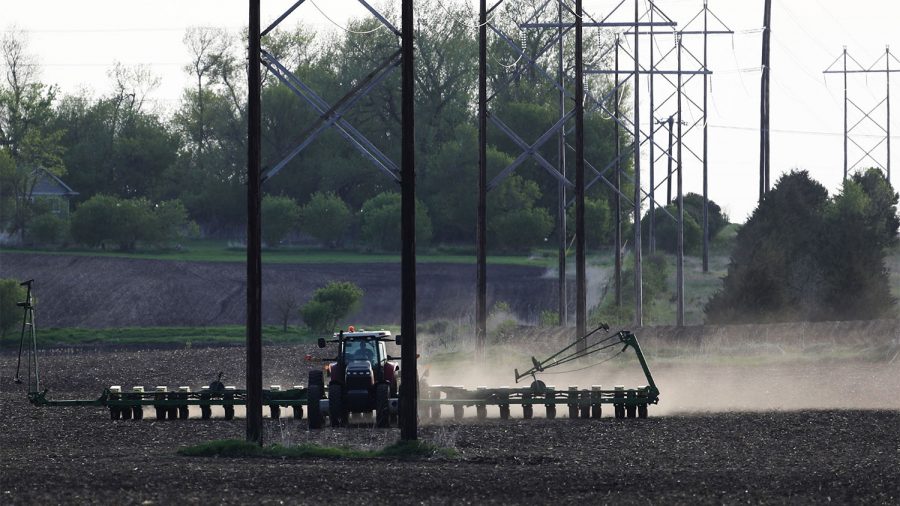Federal aid to farmers helped fill gaps, uncertainty in shutdown continues
In the wake of an ongoing trade dispute with China and a declining soybean market, the Market Facilitation Program helped keep some farm operations running, eastern Iowa soybean farmers say.
David Joles/Minneapolis Star Tribune/TNS
Crop farmer Bob Worth plants soybeans on the family farm Thursday, May 17, 2018, in Lake Benton, Minn.
January 23, 2019
Despite criticisms of the $12 billion federal aid for farmers given in the midst of an ongoing trade dispute with China, Iowa soybean farmers say the package filled gaps created by market uncertainty. However, with the government shutdown, some farmers have been kept waiting.
Grant Kimberley, the director of market development at the Iowa Soybean Association, said that the federal money helped some farmers stay in business this year.
“[The aid] helped mitigate some of the damage that’s been done during these retaliatory tariffs, and that’s really probably made the difference in some farm operations,” Kimberley said.
The federal-aid payments — the Market Facilitation Program — was announced in July shortly after China imposed retaliatory tariffs on about $34 billion worth of U.S. agriculture products and vehicles. Soybean farmers were especially affected with China being Iowa’s No. 1 customer of soybeans.
The U.S. Department of Agriculture declared that it would compensate soybean farmers $1.65 for every bushel they harvest. Kimberley said the payment was to be given in two parts, each payment adding up to approximately 82.5 cents per bushel of soybeans.
RELATED: Partial U.S. government shutdown impacts Iowa agriculture
The amount of aid farmers receive is solely based on their production from this past harvest. Kimberley said the USDA determined the $1.65 based on soybean prices in the current market, which have been steadily sliding for the past four years.
Because of wet weather during harvest months setting farmers back, some were not able to declare their yields until late December or early January. Now, with the partial government shutdown entering Day 33, some farmers have yet to sign up for the aid.
Ben Schmidt, a soybean and corn farmer in the Iowa City area, said that he signed up for the program when it was announced, but now, he has to wait to declare his total yield because of the government shutdown.
Schmidt said his farm ended up harvesting around 2,000 acres.

Crop farmer Bob Worth loads soybean seeds into his soybean planter on the family farm Thursday, May 17, 2018, in Lake Benton, Minn. (David Joles/Minneapolis Star Tribune/TNS)
“[The USDA] said there’s going to be spot checking on it,” he said. “I don’t know what that’s going to entail.
“When [the aid] was introduced I think it was seen as a little more complicated, partly because they were doing a two-process payment.”
Mark Jackson, a soybean farmer on a family-operated farm near Oskaloosa, Iowa, and a former president of the Iowa Soybean Association, said he had a high yield of soybean production this season, harvesting roughly 850 acres. Jackson submitted his paperwork to a nearby Farm Service Agency office and received his federal compensation prior to the government shutdown.
RELATED: Iowa soybean farmers feeling the heat of tariffs
Jackson said the sign-up for him was “seamless,” and he received both payments roughly six weeks apart from each other. He farms with his brother and son.
“You can come up with a fairly good size dollar figure for Jackson farms, but when you have three families and divide it three ways, suddenly, it doesn’t seem as much of a payout,” Jackson said.
However, he said, there are many uncertain variables in farming, including weather and the size of the land, so it is difficult to choose things that could make aid programs better for every farming operation. He said China is “the bad player” in the trade dispute.
Kimberley said it is important to note that one-third of the U.S. soybeans go to China, so while the federal aid helped, it did not replace the value of trading in a more open market.
“There are not enough markets in the world to make that up, so that’s why this is so critical that they do something to help, because this was very abrupt and was outside of any farmers’ control,” Kimberley said.






